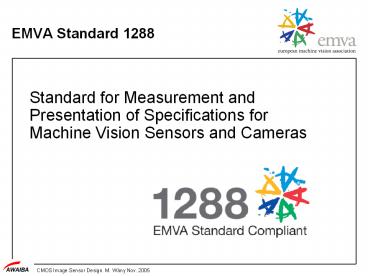EMVA Standard 1288 - PowerPoint PPT Presentation
1 / 17
Title:
EMVA Standard 1288
Description:
EMVA Standard 1288 Standard for Measurement and Presentation of Specifications for Machine Vision Sensors and Cameras – PowerPoint PPT presentation
Number of Views:81
Avg rating:3.0/5.0
Title: EMVA Standard 1288
1
EMVA Standard 1288
Standard for Measurement and Presentation of
Specifications for Machine Vision Sensors and
Cameras
2
Agenda
- Motivation
- Goals
- Approach
- Current state Outlook
- Brief presentation of first released module
3
Motivation
- EMVA Standardization Working Group launched in
February 2004 - Aim is to increase transparency of image sensor
camera specifications - Existing standards from broadcasting industry
not suitable for describing performance of image
giving systems in machine vision applications - Well-defined standards will increase
transparency for customers, prevent unfair
comparison of specification sheets, reduce
support time, facilitate selection of the right
camera or image sensor - Increase credibility of the industry
4
Participating companies
- The standardization working group is open to all
who constructively participate - Apply for registration at www.emva.org or e-mail
to info_at_emva.org
5
Goals
- Elaborate a recommendation for a specification
parameter set with clearly defined physical
definitions of each parameter - Elaborate a measurement guideline for each of the
recommended parameters - Provide information for understanding the
implication of the recommended parameters to the
performance of machine vision systems and
guidelines for conversion of the parameter to
other definition systems
6
Approach
- Modular standard framework
- New modules are to complete the standard rather
than to replace previous versions
- Module 1
- Sensitivity
- Quantum efficiency
- Dynamic range
- Spatial and temporal noise
- Over all system gain
- Module 2
- Linearity
- Artifacts
- Defect pixels
- Module 3
- Color
- Module X
- More to follow
The modular approach protects investment in
measurement equipment, processes and education
7
Current State
- First Module released in August 2005
- Logo is available at www.EMVA.org
- Full Standard available at www.EMVA.org
- Companies self certify standard compliance
First cameras characterized according to the
standard at vision PCO pco.1600 pco.2000
pco.4000 BASLER A102f A311f A312f A60xf
A631f A641f
8
Content of the Standard
- Basic Information
- This section delivers general information and
information regarding the operation point at
which data is acquired. - Vendor name
- Model name
- Type of data presented Typical Guaranteed
Guaranteed over life time1 - Sensor type (CCD CMOS CID etc...)
- Sensor diagonal in mm Indication of lens
category to be used inch - Resolution Pixel size (width x height in µm)
- Readout type (CCD only) Transfer type (CCD
only) - Shutter type (CMOS only) Global Rolling
- Overlap capabilities (readout of frame n and
exposure of frame n1 can happen at the same
time). - Maximum frame rate at the given operation point.
(no change of settings permitted) - Others (Interface Type etc..)
9
Content of Module 1
Description of Mathematical model
10
Content of Module 1 Continued
Measurement Setup
- Illumination Setup from Module 1
- Homogenous illumination
- Without lens
- F-number 8
- Definition of temperature measurements
11
The photon transfer method
Content of Module 1 Continued
- Acquire series of images at increasing number of
integrated photons (by variation of the
integration time) - Represent mean value and temporal noise over
photons - Permits to determine each parameter independently
12
The photon transfer method
- Measured Quantities
- Mean of the gray values
- (How much light generates how much signal)
- Variance of the temporal distribution of the gray
values - (How much temporal noise do we have at what
signal level)
13
The photon transfer method
- Derived Quantities
- Overall system gain
- (Responsivity of the sensor/camera)
- Total Quantum efficiency
- (QE including FF, glass ML etc..)
- Full well capacity
- (How many electrons are needed for the saturation
signal) - Absolute Sensitivity
- (How much light equals the read noise)
- Dynamic input Range
14
The spectrogram method
Content of the Module 1 Continued
- Compute and plot a row and column FFT of the
image at 3 illuminations (dark 50saturation
90 saturation) - Extract spatial noise performance from
spectrogram. - Permits to get more insight in FPN and temporal
noise performance then bare figures.
15
The spectrogram method
- Derived Quantities
- Standard deviation of the spatial offset noise
referenced to electrons in e-. - (Total FPN at a given light level)
- Standard deviation of the spatial gain noise in
. - (Total gain noise PRNU)
- Signal to Noise Ratio
- (SNR including all noise contributions)
16
Data Presentation
- Describe data presentation
- Present all data in physical units
- Refer data to photons
- Present raw data and extracted parameters
- Permits the user to check matching of the model
to the data and pick parameters relevant to their
application
17
Thank you for your attention
- Current standard draft
- www.emva.org
- Join the working group
- info_at_emva.org
- Acknowledgements
- Dr. F. Dirks Dr. G. Holst
- All members of the 1288 Workinggroup
Contact Martin Wäny AWAIBA Lda. Madeira
Technopolo 9020-105 Funchal Madeira
waeny_at_awaiba.com 351 291 723 124 / 49 4102 457
176 www.awaiba.com































